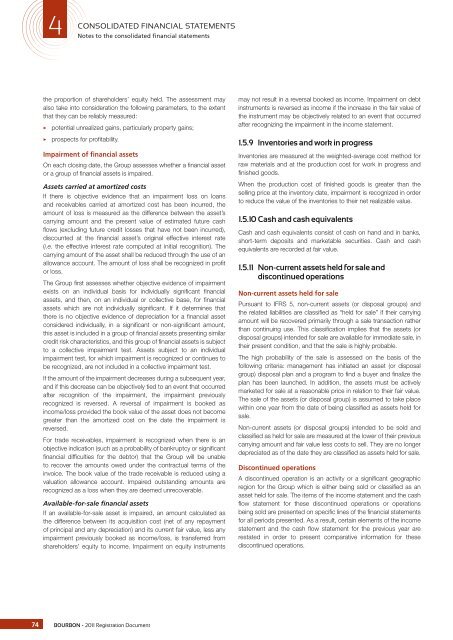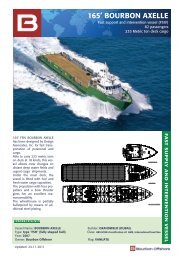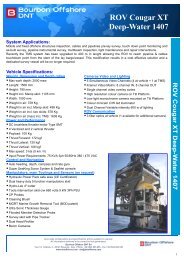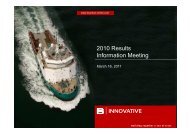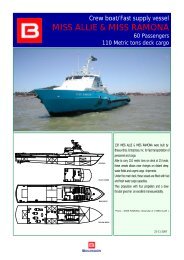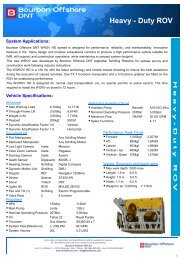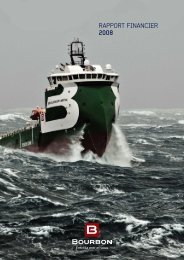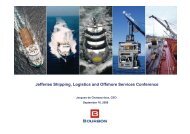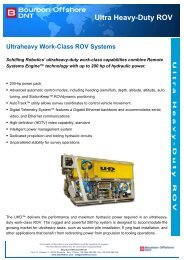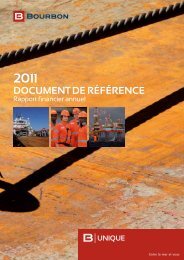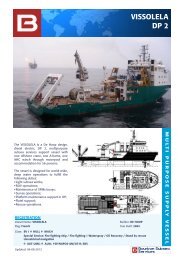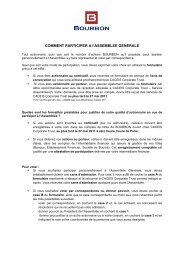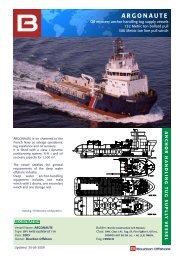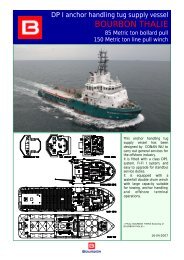REGISTRATION DOCUMENT - Bourbon
REGISTRATION DOCUMENT - Bourbon
REGISTRATION DOCUMENT - Bourbon
- No tags were found...
Create successful ePaper yourself
Turn your PDF publications into a flip-book with our unique Google optimized e-Paper software.
4NotesCONSOLIDATED FINANCIAL STATEMENTSto the consolidated financial statementsthe proportion of shareholders’ equity held. The assessment mayalso take into consideration the following parameters, to the extentthat they can be reliably measured:3 potential unrealized gains, particularly property gains;3 prospects for profi tability.Impairment of financial assetsOn each closing date, the Group assesses whether a fi nancial assetor a group of fi nancial assets is impaired.Assets carried at amortized costsIf there is objective evidence that an impairment loss on loansand receivables carried at amortized cost has been incurred, theamount of loss is measured as the difference between the asset’scarrying amount and the present value of estimated future cashfl ows (excluding future credit losses that have not been incurred),discounted at the fi nancial asset’s original effective interest rate(i.e. the effective interest rate computed at initial recognition). Thecarrying amount of the asset shall be reduced through the use of anallowance account. The amount of loss shall be recognized in profi tor loss.The Group fi rst assesses whether objective evidence of impairmentexists on an individual basis for individually signifi cant fi nancialassets, and then, on an individual or collective base, for fi nancialassets which are not individually signifi cant. If it determines thatthere is no objective evidence of depreciation for a fi nancial assetconsidered individually, in a signifi cant or non-signifi cant amount,this asset is included in a group of fi nancial assets presenting similarcredit risk characteristics, and this group of fi nancial assets is subjectto a collective impairment test. Assets subject to an individualimpairment test, for which impairment is recognized or continues tobe recognized, are not included in a collective impairment test.If the amount of the impairment decreases during a subsequent year,and if this decrease can be objectively tied to an event that occurredafter recognition of the impairment, the impairment previouslyrecognized is reversed. A reversal of impairment is booked asincome/loss provided the book value of the asset does not becomegreater than the amortized cost on the date the impairment isreversed.For trade receivables, impairment is recognized when there is anobjective indication (such as a probability of bankruptcy or signifi cantfi nancial diffi culties for the debtor) that the Group will be unableto recover the amounts owed under the contractual terms of theinvoice. The book value of the trade receivable is reduced using avaluation allowance account. Impaired outstanding amounts arerecognized as a loss when they are deemed unrecoverable.Available-for-sale financial assetsIf an available-for-sale asset is impaired, an amount calculated asthe difference between its acquisition cost (net of any repaymentof principal and any depreciation) and its current fair value, less anyimpairment previously booked as income/loss, is transferred fromshareholders’ equity to income. Impairment on equity instrumentsmay not result in a reversal booked as income. Impairment on debtinstruments is reversed as income if the increase in the fair value ofthe instrument may be objectively related to an event that occurredafter recognizing the impairment in the income statement.1.5.9 Inventories and work in progressInventories are measured at the weighted-average cost method forraw materials and at the production cost for work in progress andfi nished goods.When the production cost of fi nished goods is greater than theselling price at the inventory date, impairment is recognized in orderto reduce the value of the inventories to their net realizable value.1.5.10 Cash and cash equivalentsCash and cash equivalents consist of cash on hand and in banks,short-term deposits and marketable securities. Cash and cashequivalents are recorded at fair value.1.5.11 Non-current assets held for sale anddiscontinued operationsNon-current assets held for salePursuant to IFRS 5, non-current assets (or disposal groups) andthe related liabilities are classifi ed as “held for sale” if their carryingamount will be recovered primarily through a sale transaction ratherthan continuing use. This classifi cation implies that the assets (ordisposal groups) intended for sale are available for immediate sale, intheir present condition, and that the sale is highly probable.The high probability of the sale is assessed on the basis of thefollowing criteria: management has initiated an asset (or disposalgroup) disposal plan and a program to fi nd a buyer and fi nalize theplan has been launched. In addition, the assets must be activelymarketed for sale at a reasonable price in relation to their fair value.The sale of the assets (or disposal group) is assumed to take placewithin one year from the date of being classifi ed as assets held forsale.Non-current assets (or disposal groups) intended to be sold andclassifi ed as held for sale are measured at the lower of their previouscarrying amount and fair value less costs to sell. They are no longerdepreciated as of the date they are classifi ed as assets held for sale.Discontinued operationsA discontinued operation is an activity or a signifi cant geographicregion for the Group which is either being sold or classifi ed as anasset held for sale. The items of the income statement and the cashfl ow statement for these discontinued operations or operationsbeing sold are presented on specifi c lines of the fi nancial statementsfor all periods presented. As a result, certain elements of the incomestatement and the cash fl ow statement for the previous year arerestated in order to present comparative information for thesediscontinued operations.74BOURBON - 2011 Registration Document


